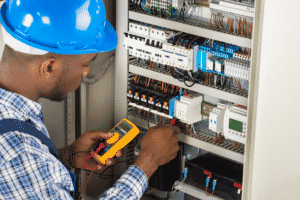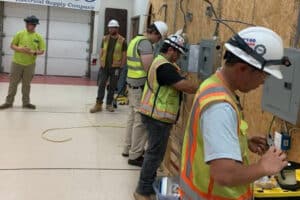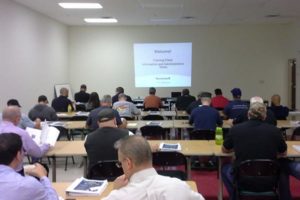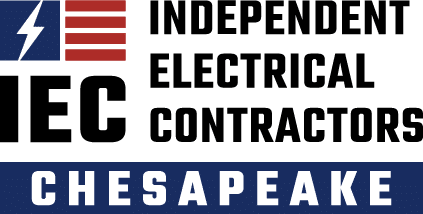It’s good to be in demand.
There’s never been a better time to join the electrical industry. An ever-increasing dependency on electrical appliances and automated systems in homes, businesses and industrial facilities has fueled the demand for trained electrical and systems technicians. Our intensive four-year electrical program is designed to provide electrical apprentices with the necessary theory and practical training to earn the status of electrician. Highly skilled tradespeople, electricians combine electrical theory, knowledge of electrical equipment, and the necessary job skills to safely and correctly perform important services for commercial and residential consumers. This includes utilizing electrical, low voltage and renewable energy for such purposes as lighting, heating, operation of electrical equipment, motor control systems and appliances.
A time-tested education that works. Taking place as traditional classroom instruction, the IEC Chesapeake’s Four-Year Electrical Program is our oldest and most popular program. Throughout the duration of the program, apprentices work full-time and attend classes two nights per week, providing the 8,000 hours of on-the-job and classroom training required for the journeyman electrician license. Because the curriculum is recognized by the U.S. Department of Labor’s Office of Apprenticeship Training, students receive nationally recognized credentials as a Journeyman Electrician upon satisfactory completion of the four-year electrical program. Most of our students enroll with the ambition of earning their Journeyman or Master Electricians License, and many graduates go on to become project managers, foremen, estimators, and business owners.

And the benefits or IECC Four-Year Electrical Program don’t stop there:
- Reviewed by the American Council on Education and up to 40 college credits may be awarded to apprentices completing four years of the IEC training curriculum to use towards a four year college program
- Offered by most of IEC chapters throughout the country for ease of transferring credits
- Transfer students are welcome
Click on the links below to view the curriculum for each year of our Four-Year Electrical Program or download the PDF.
Year One Curriculum
101: Orientation and Basic Principles
102: Tools and Fasteners
103: Introduction to Safety, Navigating the NEC® and EWR Plans
104: Introduction to Electric Charges and Basic Math
105: Applied Math, Circuit Theory, Plans & Specs
106: Applied Math, Ohm’s Law, Electrical Symbols, Boxes, and Box Fill
107: Conduit Bending
108: Dwelling Circuit Requirements, Outlet Locations, and General Lighting Load
109: Conductor Types, Ampacity, Overcurrent Protection, Type NM Cables, and Common Voltage Systems
110: Voltage Drop, Cable, Conduit, and Tubing
111: First Semester Mid-Term Review and Exam
112: Conductor Terminology, Switches, and Receptacles
113: GFCI, AFCI, and Other Special-Purpose Receptacles
114: Luminaires, Ballasts, and Lamps
115: Box Fill and Introduction to Series Circuits (Front Bedroom)
116: Box Sizing and Series Circuits (Master Bedroom)
117: Lighting and Small Appliance Branch Circuits
118: First Semester Final Exam
119: Track Lighting, Dimmers, and Introduction to Parallel Circuits (Living Room)
120: Laundry and Bathroom Receptacles and Parallel Circuits
121: Garage and Garage Door Circuits, Underground Installations, and Parallel Circuit Calculations
122: Appliance and Special Purpose Outlets
123: Ranges, Ovens, Counter-Mounting Cooking Units, and Other Kitchen Appliances
124: Bathrooms, Exhaust Fans, and Hydromassage Tubs
125: Heating and Air Conditioning
126: Residential Limited Energy Systems
127: Second Semester Mid-Term Review and Exam
128: Multiwire Branch Circuits and Introduction to Combination Circuits (Recreation Room)
129: Combination Circuits, Conductor Ampacity Correction, and Conduit Fill (Workshop)
130: Services and Service Equipment, and Cost of Electrical Power
131: Grounding and Bonding, Specialty Tools
132: Overcurrent Protection and Circuit Conditions
133: Service Entrance Calculations
134: Swimming Pools, Spas, and Hot Tubs
135: Home Automation, Standby Power, and Photovoltaic Systems
136: Second Semester Final Exam
Year Two Curriculum
201 Construction Materials
202 Printreading: Project Design, Development, and Specifications
203 Printreading Basics
204 Electrical Part I: Service, Distribution, and Panel Schedules
205 Electrical Part II: Lighting, Power, and Other Associated Drawings
206 Site/Civil and Structural Drawings
207 Mechanical and Plumbing Materials and Drawings
208 Architectural Drawings
209 First Semester Mid-Term Review and Exam
210 Code Study: NEC® Intro, Chapter 1, and Chapter 2, Articles 90, 100, 110, and 200
211 Code Study: NEC® Chapter 2, Article 210
212 Code Study: NEC® Chapter 2, Articles 215, 220, 225, and 230
213 Code Study: NEC® Chapter 2, Articles 240, 242, and 250
214 Code Study: NEC® Chapter 3, Articles 300 and 310
215 Code Study: NEC® Chapter 3, Articles 312 and 314
216 Code Study: NEC® Chapter 3, Articles 320–393
217 First Semester Exam Review
218 First Semester Exam
219 Introduction to AC Theory
220 AC Theory: Inductive and Capacitive Reactance
221 AC Theory: Impedance and Power Factors
222 Single-Phase Transformers: Theory, Types, and Calculations
223 Power Generation, Transmission, and Distribution; Introduction to Three-Phase Calculations
224 3Ø Transformers
225 Buck-Boost Transformers: Single-Phase Connections and Applications
226 Balancing Three-Phase Loads, Nonlinear Loads, Three-Phase Fault Currents, and Voltage Drop
227 Second Semester Mid-Term Review and Exam
228 Code Study: NEC® Chapter 4, Articles 400–408, 410, 422, and 424
229 Code Study: NEC® Chapter 4, Articles 430, 440, 445, 450, and 480
230 Code Study: NEC® Chapter 5, Articles 500–506 and 511–516
231 Code Study: NEC® Chapter 5, Articles 517–590
232 Code Study: NEC® Chapter 6, Articles 600–604, 620–645, and 680
233 Code Study: NEC® Chapter 6, Articles 690 and 695
234 Code Study: NEC® Chapter 7, Articles 700–705, 722, 724, 725, and 760
235 Second Semester Final Exam Review
236 Second Semester Final Exam
Year Three Curriculum
301 Test Instruments, OSHA, NFPA 70E®, and Test Instrument Safety
302 Introduction to Grounding and Bonding; General Requirements
303 System Grounding: Grounded Conductors, Systems Required to be Grounded, and Systems Not
Permitted to be Grounded
304 System Grounding: Separately Derived Systems, Main Bonding Jumpers, and System Bonding
Jumpers
305 Grounding Electrode Systems and Grounding Electrode Conductors
306 Supply-Side and Load-Side Bonding Jumpers
307 Equipment Grounding and Equipment Grounding Conductors
308 Grounding of Specific Equipment and Conditions
309 First Semester Mid-Term Review and Exam
310 DC Motors, AC Single-Phase and Polyphase Motors
311 Motors: General Knowledge and Sizing Branch Circuit Conductors
312 Sizing Motor Short-Circuit and Ground-Fault Protection; Locked Rotor Current
313 Sizing Motor Overloads and Disconnects
314 Motor Feeder Conductors, OCPDs, and Tap Conductors
315 Adjustable-Speed Drive Systems, Code, and Introduction to Motor Speed Control Methods
316 AC Equipment, Fire Pumps
317 First Semester Exam Review
318 First Semester Exam
319 Introduction to Ladder Logic, Pushbuttons
320 Manual Control Devices, Hands-On Activity
321 Automatic Control Devices, Hands-On Activity
322 Relays, Solid-State Relays, Contactors, Hands-On Activities
323 Holding Circuits, Hands-On Activities
324 Timing Relays: On-Delay, Interval, and Recycle
325 Timing Relays: Off-Delay, One-Shot, and Multifunction; Hands-On Activities
326 Ladder Logic Line Diagram: Critical Thinking Activity
327 Midterm Review and Exam
328 Magnetic Motor Starters, Control Circuit Overview, Hands-On Activity
329 Motor Power Connections, NEMA Enclosures, Hands-On Activity
330 Motor Reversing: Controllers and Connections, Hands-On Activity
331 Jogging Circuits, Latching Relays, Alternating Relays, Phase-Loss Relays; Hands-On Activity
332 Introduction to Limited Energy/Low-Voltage Systems
333 Building the Foundation of the Productive Worker
334 Transition to Supervisor
335 Final Exam Review
336 Final Exam
Year Four Curriculum
401 Energized Electrical Work Relative to NFPA 70E®
402 Introduction to Programmable Logic Controllers and Relays
403 Introduction to Programming PLRs
404 Variable Frequency Drives (VFDs): Motor Starting Methods, Accelerate/Decelerate
405 Power Quality
406 Introduction to Solar Photovoltaics
407 Introduction to Electric Vehicles, Electric Vehicle Chargers, and Energy Storage
408 Introduction to Supervision
409 Mid-Term Review and Exam
410 Introduction to Limited Energy Systems, Structured Cabling
411 Home Automation
412 Audio/Sound Systems, and Video Surveillance Systems
413 Introduction to Building Automation Systems (BAS)
414 Fire Alarm Systems
415 Predictive and Preventive Maintenance
416 Troubleshooting
417 First Semester Exam Review
418 First Semester Final Exam
419 Using and Applying NEC® 90, 100, and 110
420 Branch Circuits & Feeders, NEC® 210 and 215
421 Load Calculations, NEC® 220 – Part 1
422 Load Calculations, NEC® 220 – Part 2
423 Services, NEC® 230
424 Conductors and Overcurrent, NEC® 100, 110, 240, 310
425 Grounding, NEC® 250
426 Wiring Methods, NEC® Chapter 3
427 Mid-Term Review and Exam
428 Switches, Switchgear, Panelboard NEC® 404 and 408
429 Equipment for General Use, NEC® 400, 406, 410, and 422
430 Equipment for General Use, NEC® 430, 440, 445, and 695
431 Transformers, NEC® 450
432 Special Locations: NEC® 500-504, 511, 514, 517, and 590
433 Renewable Energy, NEC® 625, 690, 691,694, 705, and 706
434 Electrical License Exam Preparation
435 Final Exam Review
436 Second Semester Final Exam
It’s a great time to join the electrical industry.













